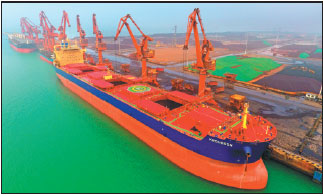
President encourages more ports in coastal areas to plant seeds of success
President Xi Jinping’s inspection tour of South China’s Guangxi Zhuang autonomous region last month has invigorated the vision for the development of the 21st Century Maritime Silk Road, local officials and entrepreneurs said.
Xi, who also serves as general secretary of the Communist Party of China Central Committee, promised vigorous efforts to promote the maritime Silk Road, and to advance opening-up under the Belt and Road Initiative, while visiting Tieshan Port in Beihai, Guangxi, on April 19.
He Xiaolong, executive deputy director of the port’s Industrial Zone Management Committee, told China Daily that the president’s inspection of the port has great significance for its strategic development.
“President Xi has encouraged us to write a new chapter for the 21st Century Maritime Silk Road. For us it means that we should innovate with modern port logistics,” he said, adding that the port will establish a new platform for industrial cooperation with the Association of Southeast Asian Nations.
Tieshan Port, a connection point for more than 240 maritime trade routes, including 26 to foreign countries, is an important hub for Southeast Asia.
The Belt and Road Initiative has “added wings to the industrial development” of Tieshan Port, He said, noting that it has led to numerous companies in industries such as petrochemical and new materials to settle in the industrial park in Beihai.
The Silk Road Economic Belt and the 21st Century Maritime Silk Road, collectively known as the Belt and Road Initiative, was put forward by Xi in 2013. The initiative aims to expand connections between Asia and the rest of the world.
The Belt and Road Forum for International Cooperation will be held in Beijing on Sunday and Monday. It will be the highest-profile international meeting on the Belt and Road since the initiative was introduced.
During the inspection of Tieshan Port, Xi asked local authorities about the future construction of the port. He encouraged authorities to construct ports in Beibu Gulf and to develop the maritime economy.
“We often say you’d better build roads first to become rich, but in the coastal areas you have to build ports first,” Xi said.
Located in the key part of the Beibu Gulf Economic Zone, Beihai has geographical advantages that help it to link China with ASEAN members through a complex traffic network including seaports, airports, railways and highways.
Mo Qiyu, general manager of the Beihai Port branch of Beibu Gulf Port Co, said the cargo-handling capacity of Tieshan Port increased from 1.17 million metric tons in 2010 to 22.1 million last year.
“General Secretary Xi was very happy when he heard this number because it took us only six years to achieve capacity that generally takes two or three decades for other ports,” he said.
Mo attributed the achievement to the region’s increasing foreign trade volume and the implementation of the Belt and Road Initiative.
Huang Qingzhou, vice-general manager of Beihai Chengde Stainless Steel Group, said the Belt and Road Initiative will bring more business opportunities to his company, which imports nearly 3.5 million metric tons of laterite nickel ore – an important raw material for stainless steel – from the Philippines and Indonesia through Tieshan Port every year.
“Along with boosting connections with Southeast Asian countries under the Belt and Road, the transportation cost of our company will be cut, making our products more competitive,” he said.
Closer links with ASEAN members will also help the company expand its market overseas, he said, adding that the fruits of China’s development will be shared with all countries along the trade routes.


